Art World
10 More Recipes From Famous Artists Who Are Getting Deliciously Creative in the Kitchen to Spice Up Their Lockdown Dining
Dana Sherwood, Olafur Eliasson, and other artists share some of their favorite recipes.
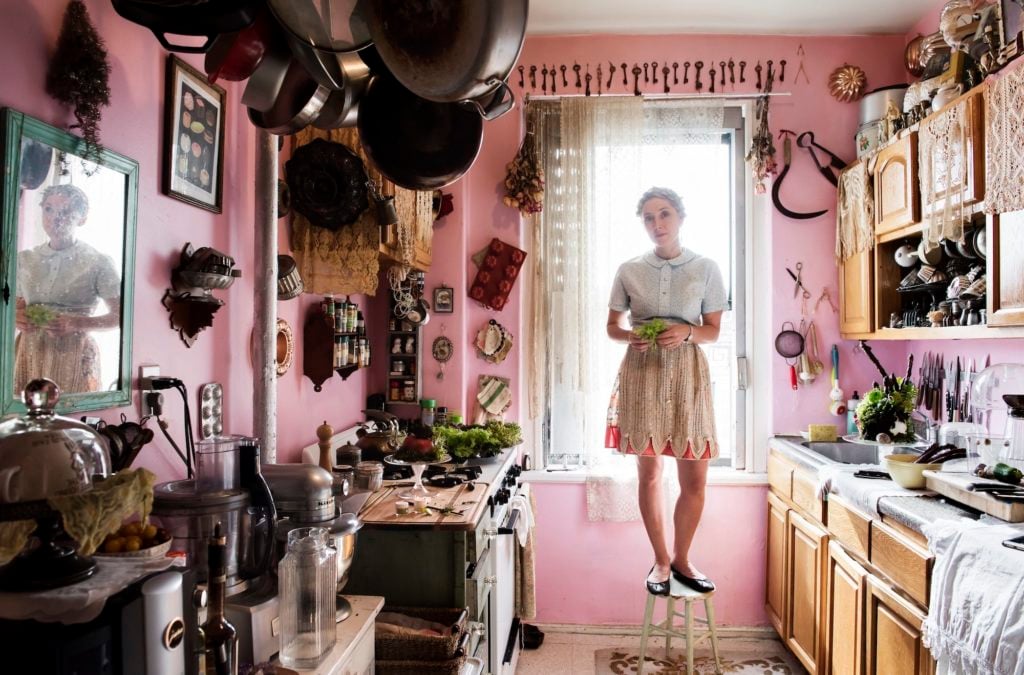
Dana Sherwood, Olafur Eliasson, and other artists share some of their favorite recipes.

Sarah Cascone

As much of the world hunkers down, practicing social distancing and sheltering in place, everyday life is shifting dramatically. And for artists, like the rest of us, that means preparing for an extended stay at home by stocking up their larders.
In search of a little culinary inspiration, we turned to artists who have worked with food in their practices, either as a material or subject matter, to ask them what they’re cooking during these unprecedented times.
Here are the dispatches they sent in from around the world—from New York, Chicago, Los Angeles, Italy, Thailand, and more—on their favorite recipes, their strategies for stocking up for long stretches, and advice special diets. So as we face this extended period of home isolation, we hope their contributions get your own creative culinary juices flowing.
Enjoy—and don’t forget to check out more artists’ recipes here.
Nikki Maloof’s paintings of animals have evolved to include domestic scenes, including kitchen paintings with fish ready to be prepped for dinner.
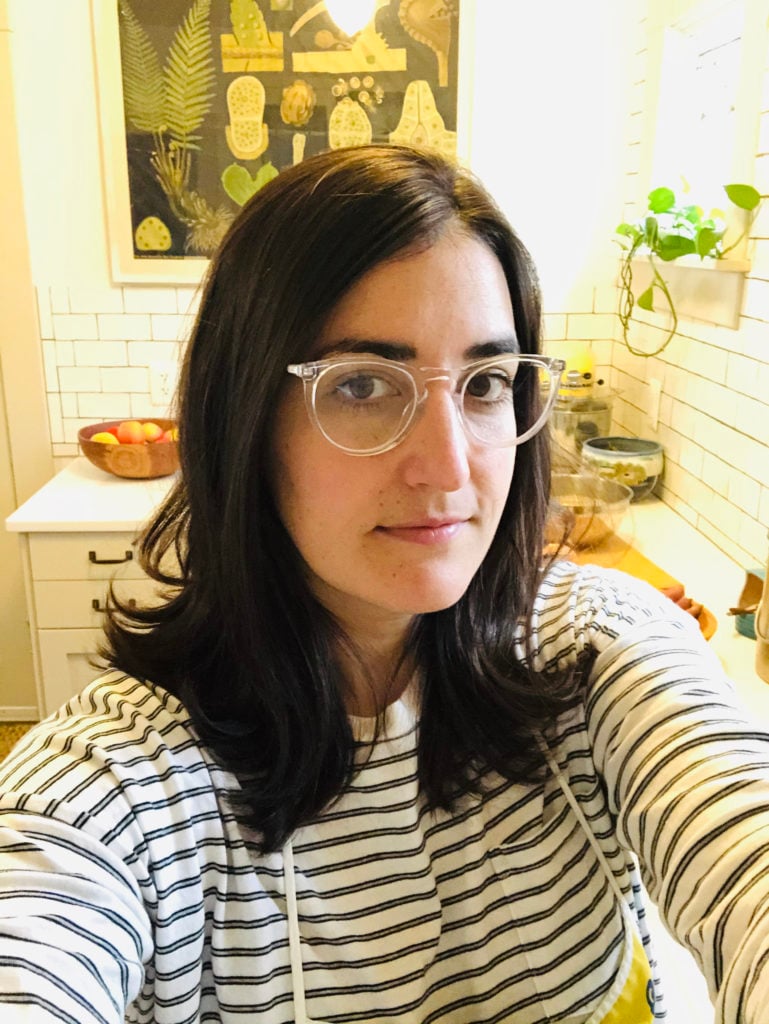
Nikki Maloof. Photo courtesy of the artist.
Truthfully, my cuisine hasn’t changed a whole lot since the lockdown. I have a tendency to cook in a frenzy a few days a week. I try to sustain myself from the energy of those cooking days for as long as possible. That’s why soups, stews, and braises are my go to. They are easy, comforting, and practical, because you can make big batches to eat later or freeze ahead. There’s nothing better than when you’ve exhausted yourself working in the studio (or worrying about global catastrophe) and you have something at home cooked waiting for you in the fridge.
The recipe I chose is for Pozole Verde. I have been known to add anything I have on hand—corn, kale, beans—but hominy is essential.
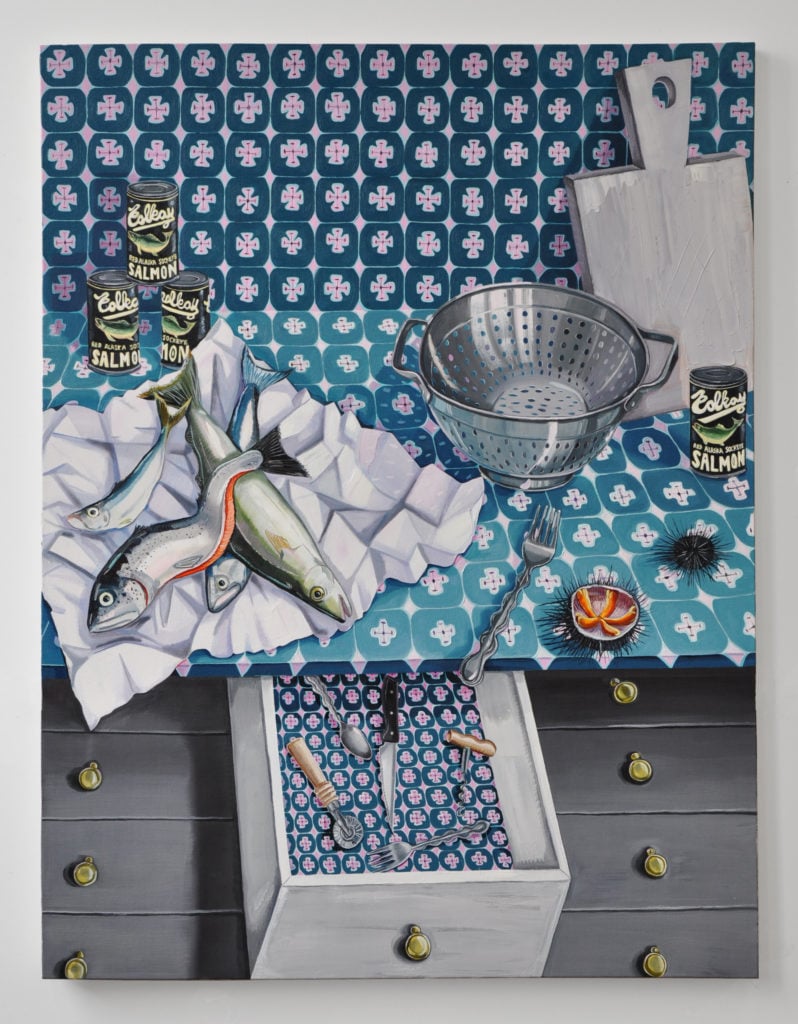
Nikki Maloof, The Midnight Kitchen. Courtesy of the artist.
Pozole Verde
Ingredients:
1 whole chicken
2 carrots
2 celery stalks
2 onions
1 head of garlic
1 bay leaf
1 bunch of cilantro
2 cans of hominy
1 can pinto beans
For the green sauce:
1½ pounds tomatillos, husks removed
1 quartered onion
1 jalapeño (or more if you like spice)
2 poblano peppers, halved and seeds removed
5 whole garlic cloves
Instructions:
Put the first six ingredients and half a bunch of cilantro in a stock pot. Fill with water until it just covers everything. Bring to a boil, then reduce temperature and cook 30 minutes until the chicken is cooked through. Remove chicken, and gingerly remove the meat from the bones once it’s not scalding hot. Put the carcass back in and continue reducing the stock while you prepare the rest.
Heat the oven to broil setting.
Throw the sauce ingredients on a sheet pan. Drizzle with oil and sprinkle with salt. Broil until there are charred parts here and there, and the tomatillos are soft. Throw everything in a blender with a handful of cilantro leaves and blend smooth. Taste and add kosher salt.
Strain the stock and put it back in the pot with the shredded chicken, green sauce, and drained cans of hominy and beans, and whatever else sounds good. Add salt to taste. Serve with dollops of sour cream, chopped cilantro, and a lime wedge.
Food is a recurring theme in Martha Rosler work. Two prime examples are her ongoing photography series “Air Fare,” documenting the artist’s meals on airplanes, and her video Semiotics of the Kitchen (1975), mimicking a traditional cooking show, with Rosler demonstrating the use of various kitchen tools in an increasingly violent manner.

Martha Rosler’s kitchen. Photo courtesy of the artist and Mitchell-Innes & Nash, New York.
I am self-sequestered at home, as ordered by the people with a clue. That’s a rowhouse in Greenpoint. My studio is most of the house, so I don’t have to leave to go to work.
I try to maintain a fairly healthy diet, mindful of the fact that I am getting far less exercise. I also want to support one or two of my local restaurants, so I occasionally get take-out. I found that at the supermarket, I wasn’t a disciplined shopper, but I did try to get salad fixings and nuts as well as some other staples and treats. Pasta was, luckily, the last thing on my mind, because as everyone now knows, there wasn’t any to be had. I do have a stock of Chinese noodles in my pantry.
I have no desire to be particularly adventurous in cooking during this crisis, as I still have to get work done without the help of in-studio assistants. I’m not sure cooking for myself alone would be worth the effort of scaring up the ingredients. My own recipe, below, requires some common elements but not everyone might have them on hand.
Here’s something simple and good-tasting that I’ve been making for years. Its origin is lost in time, but I have it copied out on a piece of paper. The smell alone makes it worth cooking.
Mediterranean Spinach
Ingredients:
6 pounds spinach, washed and drained
5 tsp salt (or to taste)
5 cloves garlic, minced
6 tbsp pine nuts
½ cup each of sliced black and green olives
2 tbsp capers
2 handfuls seedless raisins
Instructions:
Cook the spinach and salt five minutes in a little water; drain and chop. Hold aside.
Heat olive oil in a skillet, stir in garlic and pine nuts, cook until golden.
Mix in olives, capers, raisins.
Mix in spinach.
Heat quickly and serve.
Artist and chef DeVonn Francis hosts art dinner parties with his food and event company Yardy NYC.

DeVonn Francis in the kitchen. Photo courtesy of the artist.
My food philosophy focuses on a few key principles: generosity, representation, and transformation. Cooking has always been a really important way to shed light on underrepresented communities and their value sets, while simultaneously remembering that there’s so much joy and pleasure that comes from sharing and making food.
The reality of the current situation is that even before the health crisis reached New York, there were a lot of communities that were disenfranchised by our current economic climate. This has been a great way to think about how food can be a tool for empowerment and wellness. How can we as artists and chefs support health and longevity?
Right now, it’s really important that I’m making food that keeps my spirits high and is mostly vegetarian and whole-grain based. Scraps and leftovers from my refrigerator are a really great way to get creative and stay conscious of waste. It’s really important to think about waste management especially because overstocking or hoarding food can cause food insecurity problems for other folks.
In terms of stocking up, I have a little list of staples that come from both my own heritage staples as well as food that I know will either last a while or I can repurpose throughout different types of meals.
Currently, I’m in my apartment in Brooklyn, which I’ve turned into a kitchen studio of sorts. It’s been really nice because I have time to kind of reconnect with the ways in which food makes me feel good as a person, and not just someone who is an artist or a chef.
Here’s a recipe:
Paprika Roasted Cabbage
Ingredients:
1 medium-sized cone or Napa cabbage
Marinade:
⅛ cup olive oil
2 whole dry chili de árbol, crushed
2 tbsp shrimp paste (you can substitute 1 tbsp fish sauce)
1 tbsp fine sea salt
2 tbsp smoked paprika (reserve 1 tbsp paprika for dusting)
To Garnish:
Maldon salt, to taste
yogurt or labneh
Instructions:
Preheat oven to 375 degrees.
Peel away any bruised leaves from the head. Cut cabbage lengthwise into eight pieces and set aside.
In a small bowl, combine olive oil, chili de árbol, shrimp paste, and fine sea salt. Brush mixture on to the cut sides of each cabbage.
On a metal sheet rack, roast cabbage, cut side down, until wedges becomes slightly tender, about 12 minutes.
Increase oven temperature to 500 degrees. Broil cabbage for eight to 10 minutes, or until edges blacken.
Remove cabbage from oven. Immediately sprinkle with smoked paprika and Maldon salt. Serve with a dollop of yogurt or labneh.
Dana Sherwood creates elaborate sculptures that double as meals for wild animals, luring them in so she can capture them on surveillance video. The artist turns that footage into whimsical watercolor illustrations.
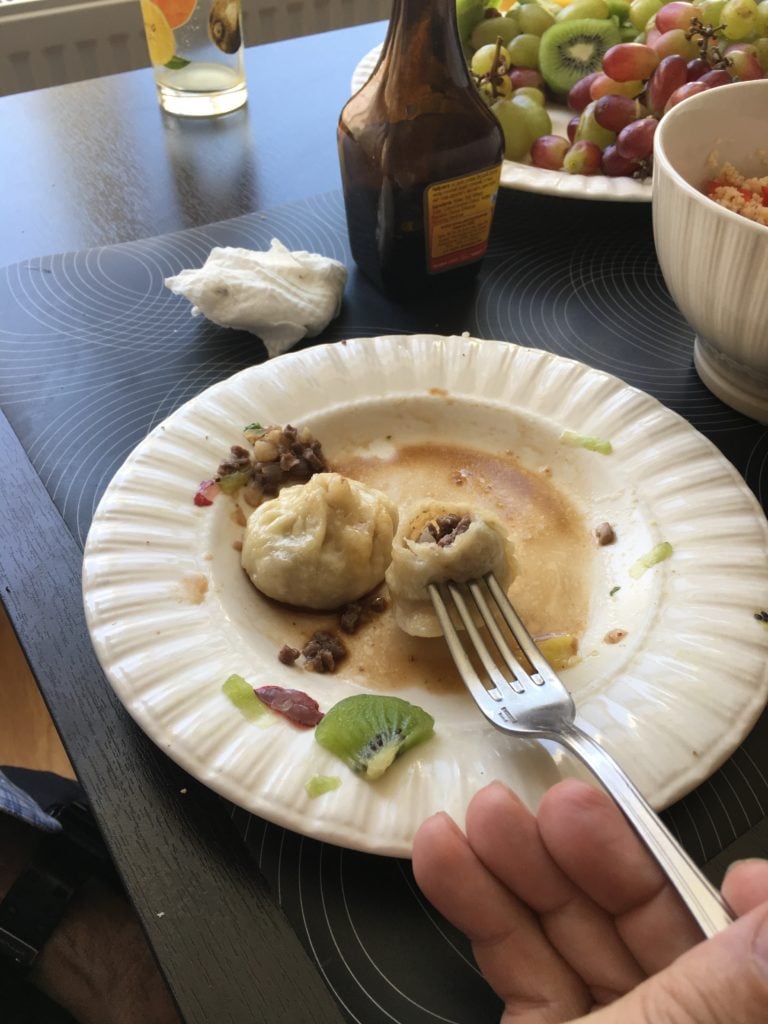
Dana Sherwood’s Mongolian buuz. Photo courtesy of the artist.
When it came time to stock my kitchen cupboards for an undetermined period of time, I found I was already pretty well stocked with basics like flour, sugar, yeast, and the like. I tend to amass food like a collector and have many exciting ingredients from my travels, like rosewater from Istanbul, tamarind paste from Indonesia, and whole buckwheat from Mongolia.
I recently got a good recipe for beans from Tamar Adler on her podcast, Food Actually. I’ve made her beans twice so far. Once with chickpeas and once with white beans. It makes a good quantity and lasts for several meals. I kind of changed it up each time, having it once with sautéed greens.
The main difference with Tamar’s recipe is to add salt right from the beginning of cooking, debunking an old food myth. The other is adding a ton of olive oil as the beans cook. So, as far as shopping for quarantine goes, I did purchase a large quantity of dried beans and garlic, as well as a lot of olive oil and butter.
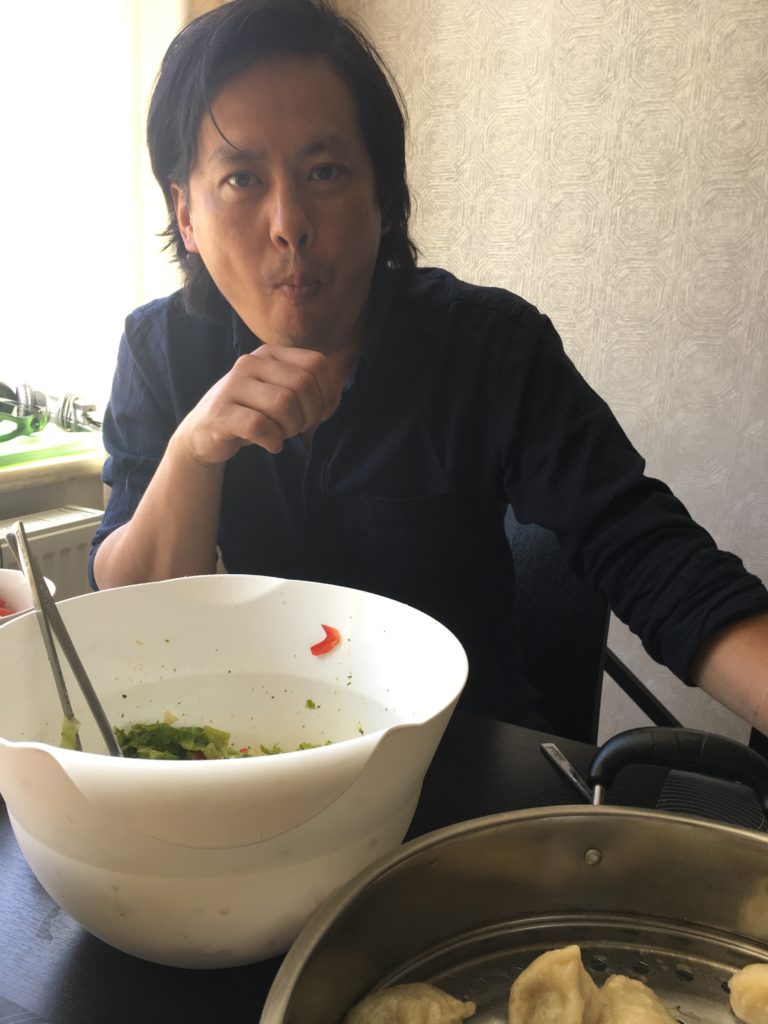
Dana Sherwood’s friend, Mongolian artist Tuguldur Yondonjamts. Photo courtesy of the artist.
The most important thing these days is community. My heart goes out to those among us who are alone, who have compromised immune systems, who have lost their way to make a living, to the imprisoned, the elderly, and all of us who are scared and unsure of what’s to come.
I am a survivalist at heart. During my recent research in Ulaan Bataar, Mongolia, I learned from the nomadic herders to add butter to my tea to give it density and satisfying fat calories. I also learned how to make very simple homemade dumplings from my friend, the Mongolian artist, Tuguldur Yondonjamts. It is remarkably easy to do.
Mongolian Buuz
Ingredients:
1 lb ground lamb (or beef if you don’t have lamb)
1 small chopped raw onion
flour
water
salt
oil
Instructions:
First, mix the chopped lamb and the onion in a bowl and mix it up with your (sanitized) hands. Add a pinch of salt.
This is a little vague, but that’s kind of how they roll in Ulaanbaatar. Mix flour, a tiny bit of salt and water until it is the consistency of pizza dough, not too sticky. You can add a little oil to this mix if you like. Roll the dough into a log and cut into ½ inch slices so you have a flat disc the size of a cookie. Coat your hands with flour to keep the dough from sticking as you form little, flat tortillas in your palm. You can also roll them out on a board with a rolling pin if that’s easier.
Try and get the dough in your palm as thin as possible, then drop a heaping teaspoon of the meat mixture into the center.
Then you pinch all the edges together until you have a little dumpling shape like a gyoza or a juicy bun.
Grease your steamer basket (we use a veggie steamer because we don’t have a fancy dumpling steamer) with butter or oil and steam for 10 minutes or so until cooked.
Eat with dumpling sauce made from soy sauce and rooster sauce or similar… however you like your dumplings!
Jennifer Rubell has found her niche in food performance art, serving up annual art-themed breakfasts at her family’s private art space during Art Basel Miami Beach and letting visitors to New York’s Meredith Rosen Gallery pie her in the face.
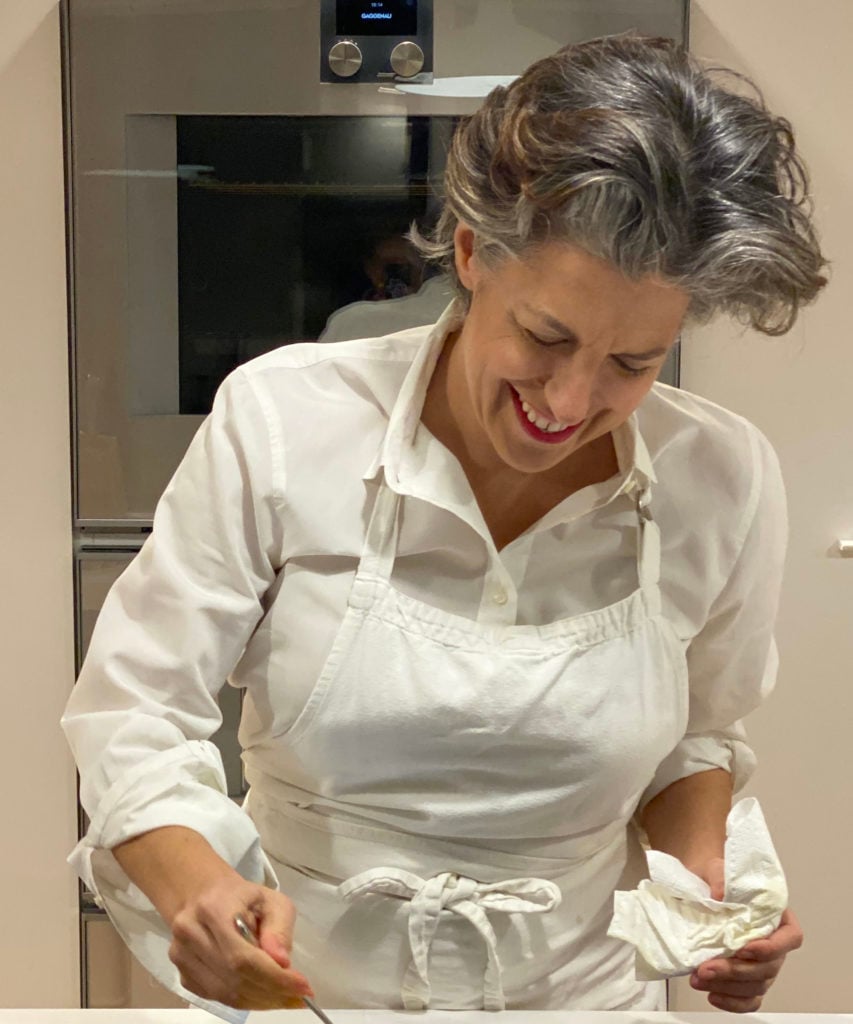
Jennifer Rubell. Photo courtesy of the artist.
Green Beans With Caper Vinaigrette and Kale-Chip Crumbs
Tip and tail a bunch of string beans. Boil them in salted water, then drain.
Meanwhile, make the vinaigrette. Whisk 2 teaspoon of lemon juice and a teaspoon of dijon mustard. Add a few drops of sherry vinegar if you have some around. Slowly add in 2 tablespoons of olive oil, whisking to emulsify. Add a couple dozen capers. Done.
Throw the string beans in the vinaigrette. Add salt and pepper.
Mix it around and put it on a plate, still warm.
https://www.instagram.com/p/B92lhw4lVYI/?utm_source=ig_embed
Take some leftover kale chips (eight, 10, whatever), put them in a plastic bag, and crumble them. Pour them on top of the string beans.
Be aesthetically attentive to the plating, obviously.
Preheat the oven to 350 degrees. Wash and dry like a half a bunch of kale, rip off the hard stems, break them into big pieces. Toss with a very little bit of olive oil, maybe a teaspoon. And no salt (kale is weirdly naturally salty). Put them on a sheet pan, with nothing touching anything else. Bake them til they just start to look a little brown in places. They should be crispy. Done. Maybe like 15 minutes. Store them in an airtight bag if you have any left over.
Art duo Friends With You—Samuel Borkson and Arturo Sandoval III—incorporates food imagery in some of their paintings. Most recently, they contributed to We All Rise, an artist coloring book being handed out to food insecure Detroit public school children with free dinners from local gallery gallery the Library Street Collective.
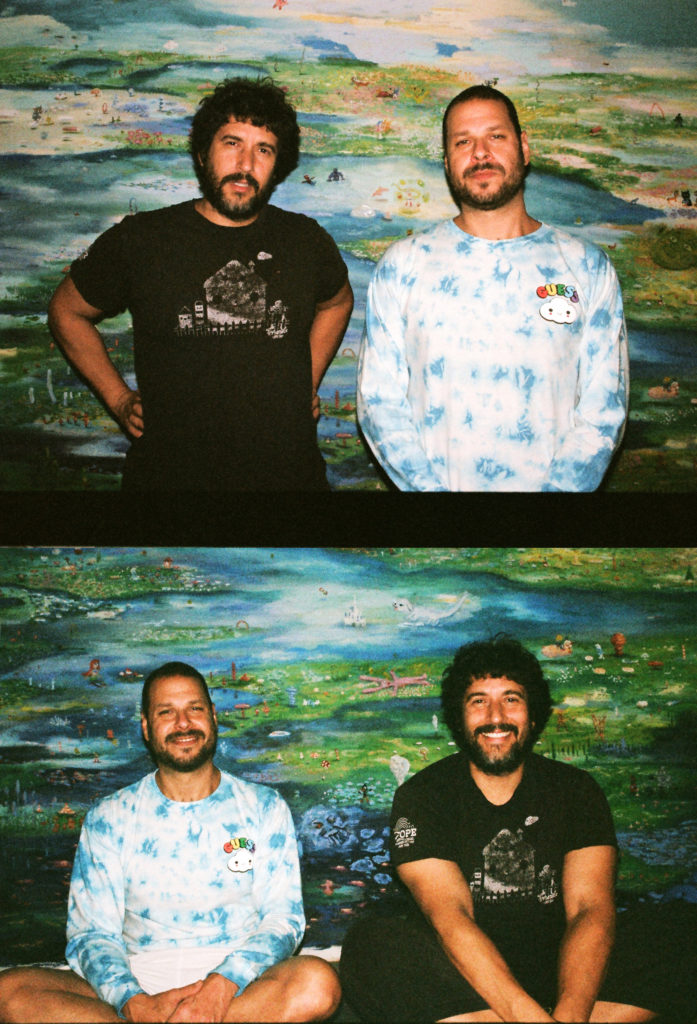
Friends With You’s Arturo Sandoval II and Samuel Borkson. Photo courtesy of the artists.
Borkson:
I have a great vegan collard green recipe.
Vegan Collard Greens
Brown a full sweet onion with coconut oil or vegan butter.
Then add lots of garlic, finely chopped.
Add greens, apple cider vinegar, and a can or two of diced tomatoes.
Season with salt, pepper, and Louisiana hot sauce.
Bring to a boil and let simmer about 20 mins or so, keeping those greens alive and nutritious.
Happy cooking!
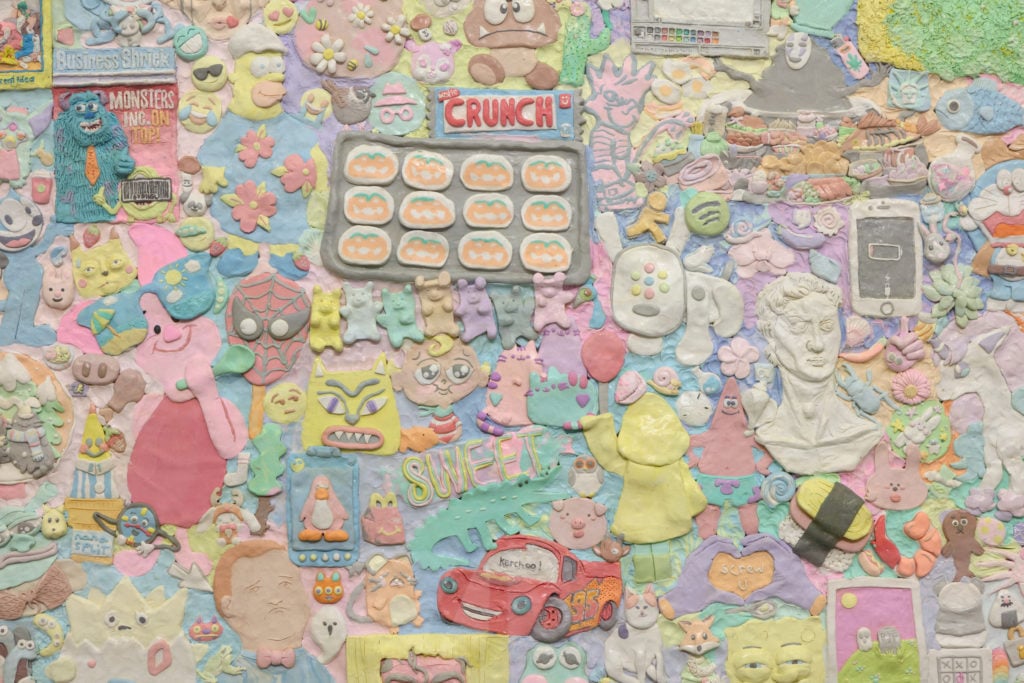
FriendsWithYou, Interness (2019). Photo by Kevin Todora, courtesy of the artists and Dallas Contemporary.
Sandoval:
Here is my Grandma Cirita’s black beans recipe. This is my number one comfort food for clean fuel!
Grandma Cirita’s Black Beans
Ingredients:
2 tablespoons olive oil
1 small onion chopped small
3 garlic gloves minced
½ large red pepper cut into 5–6 irregular shaped chunks
1 dried bay/laurel leaf
2 cans of plain organic black beans
1 cup water
1 tsp apple cider vinegar
1 tsp sugar (white, brown, coconut, or even maple syrup works!)
½ tsp ground cumin
½ tsp oregano
½ tsp salt (or more to taste)
⅓ cup of Manzanilla green olives (pimento stuffed—no pit)
Instructions:
Make the sofrito (sautéed taste bomb!) by placing the olive oil, onion, garlic, bay leaf, and red pepper into a medium-sized pot. Sauté on medium heat, stirring often, until the onions begin to brown slightly.
Add the two cans of black bean (with the liquid and everything) as well as the cup of water. Also stir in the cumin, salt, and oregano. Bring to a boil.
Once boiling, add the vinegar and the sugar. Reduce to a simmer.
Once simmering, mix in the olives and cover.
Simmer covered for 45 minutes, stirring often to avoid sticking to the pot. Once the beans have thickened, they are ready to serve. Serve over white rice and enjoy!
Olafur Eliasson isn’t much of a cook himself, but he sees food as part of his practice, publishing a cookbook in 2017. Titled The Kitchen, it features vegetarian recipes from the kitchen of his Berlin studio, which makes lunch for the artist and his team every day.

Ólafur Elíasson, Christine Bopp, Lauren Mauer, Montse Torreda, Victoría Elíasdóttir, Leifur Kolbeinsson, and Nora Wulff at Eliasson’s studio in Berlin. Photo by María del Pilar García Ayensa, courtesy of the artist.
We’d like to share with you simple, seasonal recipes, with vegetarian and vegan options, that we would cook for ourselves, our families, and our friends at home when we have little time on hand. This is soul food pasta for an easy-going evening at home.
Simple Pasta
Serves 2 people (please double or triple or increase as needed)
Ingredients:
Approximately 10.5 oz pasta
2–3 leeks
1 head of radicchio (or chicory)
1 handful of almonds (or hazelnuts, sunflower seeds, or walnuts)
approximately 4.5 oz chèvre goat cheese (or feta or Parmesan, or vegan without cheese)
olive oil
approximately 6 tbsp balsamic vinegar
salt
pepper

The ingredients for Simple Pasta. Photo by Studio Olafur Eliasson Kitchen.
Instructions:
Preheat the oven to 390 degrees.
Roast whole almonds in the oven for five to seven minutes.
Wash and cut the leeks in three-quarter-inch rings, mix with oil, salt, and pepper and distribute on a tray,
When the almonds are done, put the leeks in the oven and roast at 390 degrees until lightly browned, about 10 to 15 minutes.
Cut the radicchio roughly, into eight to 12 pieces.
Boil the pasta in salted water.
Sauté the radicchio with olive oil and salt in a wide pan until it’s wilted and lightly browned. Add balsamic vinegar and stir to combine.
Crumble the cheese.
Serve separately if you wish or mix the radicchio into the pasta, serve in bowls and top with the leeks, cheese, and almonds. Add freshly ground pepper and salt to taste.
For the vegan option, add fresh herbs, finely chop the almonds and mix with salt for a topping, or add sweet or rosemary roasted nuts.
Zina Saro-Wiwa’s work celebrates the culture of Nigeria’s Niger Delta region, with a special focus on the cuisine. Her video series “Table Manners” captures residents of the Niger Delta consuming a meal for the camera. The artist has also held elaborate West African dinners at the Blaffer Art Museum in Houston and Third Streaming Gallery in New York.

Zina Saro-Wiwa in her garden. Photo by Zina Saro-Wiwa.
The comedian “Fat Carrie Bradshaw” said it best in his Twitter comment: “I am either going to come out of this quarantine 50 pounds lighter or 100 pounds heavier. Only time will tell.”
I myself am experiencing a sort of dietary schizophrenia. On the one hand I am eating very healthily—my body feels like it wants to cleanse—but then on the other I want to be comforted because of all the stress we’re all under.
There is, sadly, a difference between looking after yourself and comforting yourself. And for me comforting myself means almond butter-filled dark chocolate, “high-end” fructose-free hibiscus gummy candies, double chocolate Milanos dipped for a millisecond in piping hot Earl Grey tea, and salt and vinegar Taytos crisps. Also quesadillas. I’m making cheesy, crispy, hot breakfast quesadillas. Lord help me.
But I started my quarantine (last Thursday) eating Nigerian food. Okra soup and garri, black-eyed bean porridge and fried plantain. It’s just something my soul needed to feel settled. Grounded. This “soul food” happily falls into both camps of looking after and comforting myself. The ingredients aren’t easy to find in LA though.
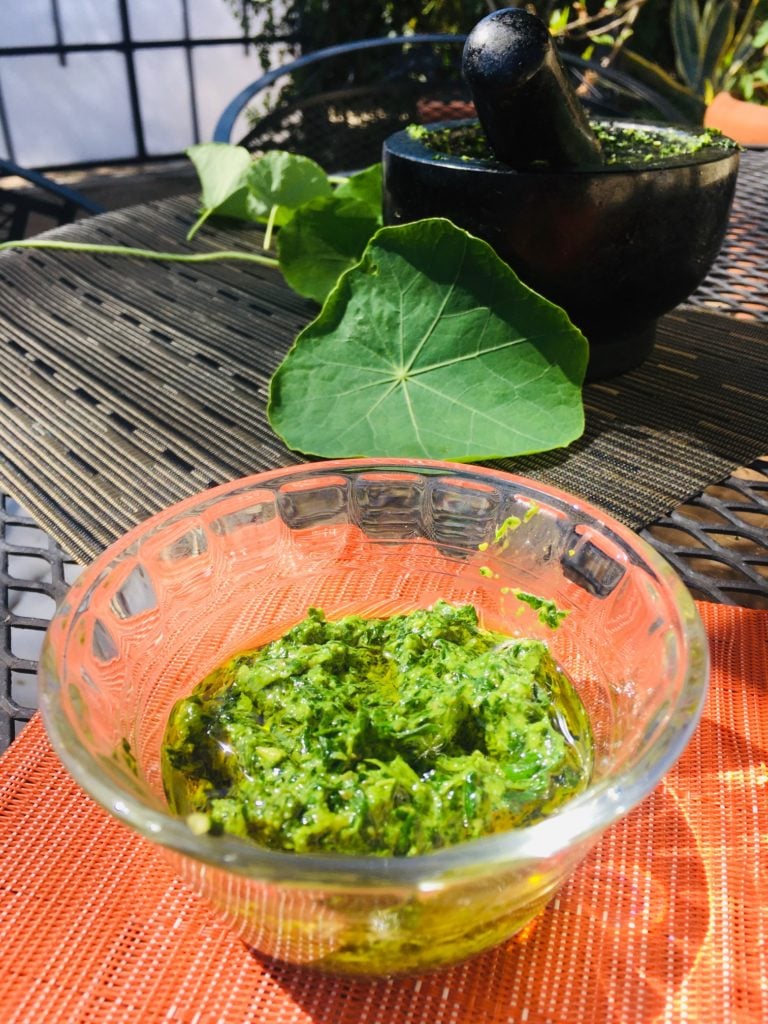
Pesto made from nasturtium in Zina Saro-Wiwa’s garden. Photo by Zina Saro-Wiwa.
I’m very well stocked with fruit, frozen kale, proteins, beans, lentils, rice, and also my beloved plantains. But I’ll share with you the recipes for some of the quarantine meals I’m preparing that feature ingredients found in the garden where I live in LA.
First up is nasturtium pesto. There is a surfeit of nasturtium in the garden. It is everywhere. I am on a pesto kick (the pestle and mortar pounding is a real tension reliever) and I picked several nasturtium leaves and washed and dried them. Then I pounded two garlic cloves and two salted anchovies in the mortar, adding the nasturtium bit by bit. Then I threw in a teaspoon of capers, lemon juice, and some pine nuts. More pounding.
There is no parmesan in this pesto. The anchovies deliver the umami and the pine nuts deliver the creaminess. The pesto is pretty fabulous. Peppery, vivacious and chlorophyll-y.
I stirred it into some gluten-free spaghetti and topped it with a soft-boiled egg and steamed asparagus, and then I shaved some pillowy aged parmesan on top because I couldn’t not. Next I want to try the pesto as a crust on some salmon which I will air-fry. I’ll add some of the peppery edible nasturtium flowers into the pesto too when I do.
Then there are the kumquats which grow right next to my outdoor dining table/work station. Again I use my pestle and mortar and gently pound three ripe kumquats, then pour the bruised fruit into a glass and pour very hot water on it and let it steep to make tea. I don’t add honey, but you can. It’s super refreshing and cleansing.
The kumquat is oily as well as astringent, so I use the juices and oily pith on my skin when I want to give myself a facial.
Both kumquats and nasturtium are high in Vitamin C and great for your immune system. There is something wonderful about eating right from the garden at this time. Almost certainly a foreshadowing for our collective agricultural futures…
Liza Lou rose to prominence in 1996 with her monumental installation The Kitchen, which took five years to make and featured millions of glittering glass beads, covering every surface of a full-sized kitchen.
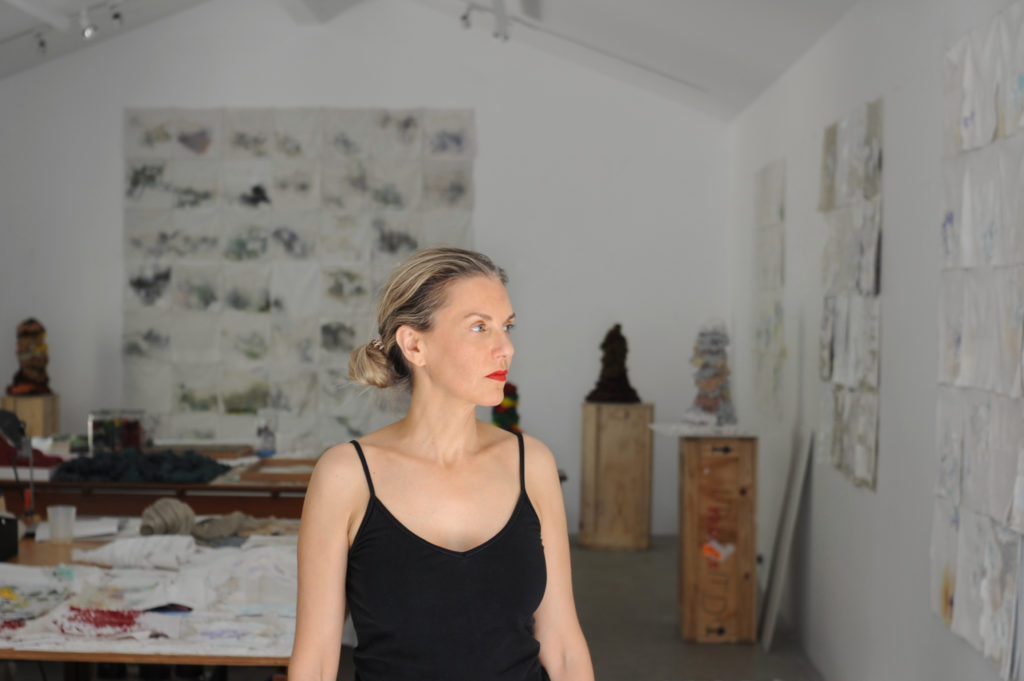
Liza Lou. Photo by Mick Haggerty, courtesy of the artist and Lehmann Maupin, New York, Hong Kong, and Seoul.
Right now it feels important to have a nourishing breakfast that calms. Try my cozy-super-easy-oatmeal
Oats—ideally Irish cut oats, but any kind will do—follow directions on package.
Add some add-ons to taste! The point here is savory, not sweet. Here’s what I added this morning:
pinch Maldon salt
½ avocado
green nori seaweed seasoning
sesame seeds
chopped almonds
splash of hemp milk
At the 2017 Whitney Biennial in New York, Pope.L nailed 2,755 slices of bologna to the pink walls of his Bucksbaum Award-winning piece Claim (Whitney Version), which featured a tray at the bottom to catch the curing meat’s oily juices.

A photo of the supermarket by Pope.L. Photo ©Pope.L, courtesy of the artist and Mitchell-Innes & Nash, New York
3.18.20, “Today I Went To The Supermarket. —On Kawara.”